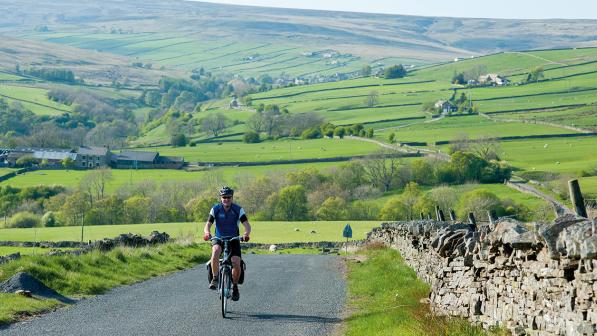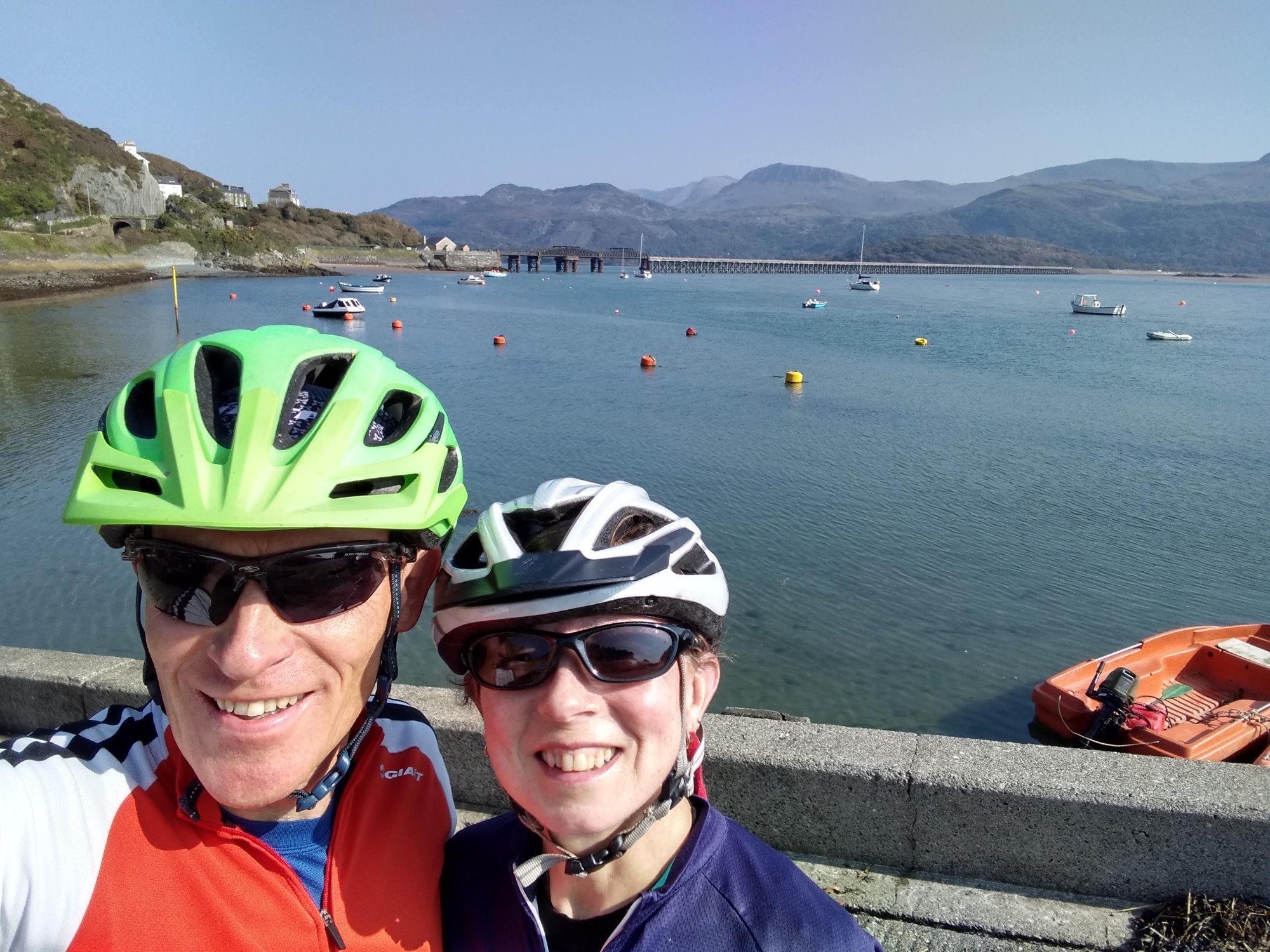Coasting across England

The views are breathtaking when you cycle across northern England from the Irish Sea to the North Sea. Unfortunately, so are the climbs. I hadn’t done any long-distance cycling for some time; in fact, cycling full stop had been on the back burner. So I decided to cheat. I would do the 140-mile, three-day route on an electric bike.
That way I could relax and enjoy the scenery. It would also let me find out how practical it was to ride a long-distance route with electric-assistance. How far would I really get on one charge? And would businesses be happy to top up the bike’s battery when it ran out of juice?
I was joined on the ride by Steve Woods, who also borrowed an electric bike. Each bike weighed in excess of 20kg without luggage, so we decided to take the ‘supported’ option. Saddle Skedaddle took our overnight bags to our chosen B&Bs ahead of us, transported us to the start, and were on the end of a phone in the event of emergency mechanicals. This, it turned out, was a wise decision.
Assault on batteries
A blue cloudless sky and warm sea breeze greeted us as we pushed the bikes to the traditional starting point in the former coal-mining town of Whitehaven: the beach. We dipped our rear wheels into the Irish Sea (the front ones had electric motors in), and set off. Neither of us had ridden an electric bike before so we zoomed about, pressing buttons and experimenting with the power settings. We were confident that the promised battery range of 50 miles or so would at least get us to our first scheduled stopping point in Keswick.
The miles flew by. We effortlessly crested any climbs, pedalling through splendid scenery at a steady 12mph. Then, with 20 miles under our belts, we found ourselves at the bottom of our first big test: the two-mile grind up Whinlatter Pass.
The battery went from green to red to STOP! I was suddenly pedalling a very heavy bike by muscle power alone – uphill."
Overgeared road bike riders struggle up here. We would not: we popped the boost button to ‘Sport’ mode to get the most assistance. Within yards, the battery light went from green to red to STOP! The loss of power was sudden and the bike nearly toppled over. I was suddenly pedalling a super-heavy bike by muscle power alone – uphill. Disaster!
Steve is fitter than me so we swapped his bike’s battery for mine. He would have the training ride of his life on a heavy, unpowered bike while I’d continue with power-assistance... except his battery also drained to empty within minutes of setting off.
Part of the problem was that we hadn’t read the manual properly. There is no such thing as a free ride with electric bikes; the power has to come from somewhere, and the less effort you put in and the faster you go, the more the battery will have to make up. In Sport mode, I was generating about 30% of the power while the battery was producing 70%. Charging up Whinlatter Pass, with 20 hilly miles already ridden, this wasn’t sustainable.
In hindsight, what we should have done was turn the battery power to Eco mode and spin the pedals lightly in the easiest gear. We’d have gone slower but we might at least have made the climb! As it was, we walked.
Time to recharge
Luckily, Whinlatter Forest Park is near the summit, complete with a bike shop – Cyclewise – and a café. The staff at the bike shop agreed to charge our batteries while we refuelled at the café.
From the trail centre, we were treated to a grand descent into Keswick, grins back on our faces and fingers firmly pressed on the off button. We wanted to be in Penrith before dark.
The rest of the day went pretty much according to plan. We were some way behind schedule, having squandered our power assistance and then lost more time recharging. Still, we had at least discovered that people were happy to charge electric bike batteries for us as we went.
After another pitstop at the Greystoke Cycle Café, we had five more miles for tired legs and waning batteries to complete before we could rest at the Norcroft B&B in Penrith. Owner Paul Lamb had completed the C2C himself, so was able to provide advice as well as a hearty breakfast next morning.
Over the Pennines
We knew that day two would be tough, as we would cross ‘the backbone of England’ – the Pennines. The day started as it would go on: with a climb to get out of Penrith.
Having learned our lesson the hard way the day before, we used the batteries sparingly. We zigzagged up the hillside, climbing towards Hartside. The views were fantastic but our enjoyment was short lived. My bike developed a terminal mechanical.
I swapped bikes with Steve, while he phoned through to the Saddle Skedaddle support crew to bring out a replacement – a conventional one, as it happened, without electric assistance. By the time I reached the summit, Steve and his replacement bike were waiting patiently, the now spare battery charging at the café.
We had an exhilarating descent towards Garrigill. The landscape was changing: the hills were pockmarked by old scars from lead and silver mining. The rollercoaster road into Garrigill flew by with the aid of a little boost now and then. But the climb out of the town exhausted the battery once more. Luckily our route down to Nenthead led us straight to North Pennine Cycles, where we could get energy bars for us and some charging time for the battery.
We needed both. The climb out of Nenthead loomed large within minutes of setting off. We settled into an extremely slow pace. But before long, we were at the highest point of the trip: Blackhill, at 609 metres. From here we dropped down to Allenheads, where we found a great little stop, The Hemmel Café. We bought homemade cakes while the staff kindly offered to charge the battery once more for our final push of the day. The aptly named Crawley Side Road climb out of Stanhope delivered us to our final digs of the trip: Parkhead Station Tearooms and B&B.
Next stop: the North Sea
From here, it was surely all downhill. The weather had turned, however. A biting headwind literally took our breath away, in stark contrast to the warm spring conditions we had enjoyed over the first two days.
The route from Parkhead Station B&B joins the Waskerley Way, a path that was once a private railway from Parkhead Quarry all the way down to Consett ten miles away. Without the wind and driving rain it would have been glorious; as it was, it was a slog across a barren, windswept landscape.
The final 20 miles were unremarkable: flat cyclepath riding through bland urban scenes. The highlight here was crossing the Gateshead Millennium Bridge, which reminded us that the end was near.
We pushed on, wet, cold and weary, along the coastal path that overlooks the North Sea, finally catching sight of the ‘finish line’. It wasn’t a place where we could dip a wheel into the sea, so we went a little further, up one final little climb – on which the battery died for the last time.
After a descent and a laborious push over soft sand, we had completed our wheel-in-the-sea ritual and were done. All we had to do was catch our lift back to Penrith.
Would I do the coast-to-coast again? Certainly. But although I’d discovered that you can do longer rides on an electric bike, covering distances and climbs that some might find impractical or impossible without assistance, I think I’d just take my usual road bike – and get a few miles in beforehand to regain some fitness.
This was first published in the December 2012 / January 2013 edition of CTC's Cycle magazine.


